

07/2005
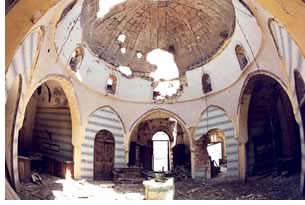 The
World Monuments Fund (WMF), a nonprofit organization dedicated to preserving
the historic, artistic, and architectural heritage worldwide, released
on June 23 its 2006 World Monuments Watch list of 100 Most Endangered
Sites. The biennial list calls for action on behalf of threatened monuments.
By bringing the sites to international attention, the list helps to raise
the funds needed for their rescue and often spurs local governments and
communities to take an active role in protecting cultural icons in their
regions. For many landmarks, the WMF reports, inclusion on the list is
the best—and perhaps the only—hope for survival.
The
World Monuments Fund (WMF), a nonprofit organization dedicated to preserving
the historic, artistic, and architectural heritage worldwide, released
on June 23 its 2006 World Monuments Watch list of 100 Most Endangered
Sites. The biennial list calls for action on behalf of threatened monuments.
By bringing the sites to international attention, the list helps to raise
the funds needed for their rescue and often spurs local governments and
communities to take an active role in protecting cultural icons in their
regions. For many landmarks, the WMF reports, inclusion on the list is
the best—and perhaps the only—hope for survival.
This year—for the first time in the 10-year history of the World Monuments Watch—the list includes an entire country whose cultural heritage is at great risk: Iraq, within whose borders lie some of the world’s most significant archaeological and architectural sites. The 2006 Watch list features sites from 55 countries on all seven continents, including:
- 32 in Europe
- 26 in the Americas
- 22 in Africa and the Middle East
- 18 in Asia
- 1 in Antarctica
- 1 in Australia.
The sites present a diverse array of our architecture heritage, ranging from the most ancient to three Modern sites—two in the U.S.—that are in danger of extinction. The WMF has grouped these sites with interesting categorizations that include: conflict and catastrophe, preserving Modern buildings, antiquity in the modern world, losing sacred sites, development pressures, and remoteness.
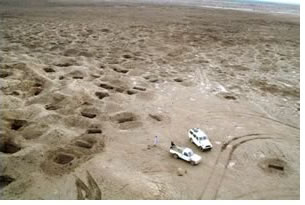 Conflict and catastrophe
Conflict and catastrophe
Several sites on the 2006 Watch list have been threatened by conflict.
Some have survived years of devastating wars; others are in the midst
of combat. Among these sites is the entire nation of Iraq, which marks
the first time in its 10-year history that an entire country has been
placed on the list. Within its borders is the 10,000-year-old “Cradle
of Civilization” between the Tigris and Euphrates rivers and an estimated
10,000 sites chronicling thousands of years of history. The WMF reminds
us that it was in this ancient land that the Sumerians wrote humanity’s
first words and planned its first cities and the Babylonian king Hammurabi
enacted the first-known code of law. Decades of political isolation,
then war and looters have damaged and put at risk sites such as the
Assyrian capital of Nineveh, the ziggurat at Ur, the temple precinct
at Babylon, and a ninth-century spiral minaret at Samarra, which are
being ravaged by looters who work day and night to fuel an international
art market hungry for antiquities.
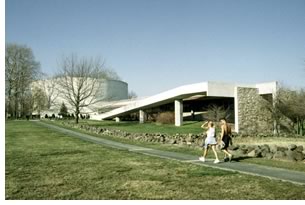 Preserving Modern buildings
Preserving Modern buildings
The greatest threat to Modern buildings is public apathy or a lack of
understanding or confidence that buildings of our own time may be important
enough to be preserved for the future, the WMF says. The list includes
the Cyclorama Center, Gettysburg, Pa., by Richard Neutra, which opened
in 1963 as part of “Mission 66,” a government initiative
to improve America’s national parks with visitors centers. Neutra’s
350-foot-circumference, 25-foot-tall Cyclorama Center houses a large-scale,
360-degree panoramic painting by French artist Paul Philippoteaux,
which depicts Pickett’s Charge, the famous last battle of Gettysburg.
Accessed by a monumental ramp, the roof of the Cyclorama Center, which
sits on part of the site of Pickett’s Charge, overlooks the battlefield.
The Cyclorama Center, which suffers from years of deferred maintenance,
is slated for demolition to recreate the 1863 battlefield landscape,
a decision endorsed in 1999 by the Advisory Council on Historic Preservation.
Joining the Cyclorama Center on this year’s endangered list are
2 Columbus Circle, in New York City, by Edward Durrell Stone, and the
International Fairground at Tripoli, Lebanon (1963–1974), by
Oscar Niemeyer.
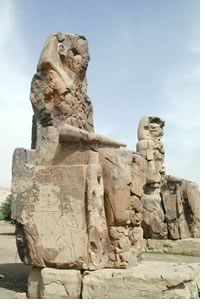 Antiquity in the modern world
Antiquity in the modern world
Many ancient sites have survived for hundreds and even thousands of years,
only to be faced now with the extraordinarily powerful threats that
include pollution, roadway and railroad construction, and uncontrolled
development. Among the ancient sites on the 2006 Watch list are: West
Bank, Luxor, Egypt, which ranks among the richest and most important
archaeological zones in the world. Within its 3.5 square miles are
the Valley of the Kings and Valley of the Queens, the burial places
of Egypt’s New Kingdom rulers (ca. 1540–1075 B.C.); the
village of Dier al-Madinah, home to the artisans who created so many
of the monuments; the palace-city of Malqata; more than 5,000 nobles’ tombs;
countless shrines; Paleolithic workstations; and some 40 temples.
The monuments of the Theban Necropolis are threatened by theft and
vandalism, uncontrolled tourism, neglect, and development pressures.
Yet the most urgent problem is that of rising groundwater in the wake
of the construction of the Aswan Dam four decades ago, which has damaged
ancient buildings and sculptures lying on the ground and has invited
agricultural encroachment onto newly fertile lands in and around the
ancient monuments.
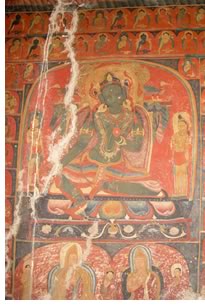 Losing sacred sites
Losing sacred sites
An increasingly common threat faced by many religious sites around the
world is the loss of their congregations, along with the ensuing lack
of funds needed to undertake conservation work and perform routine
maintenance. Examples of these sites include the Guru Lhakhang and
Sumda Chung Temples, Sumda Chung, India. This early period of Buddhist
monastic architecture in the Western Himalayan region, characterized
by close links between Tibet and India, was formative in the evolution
of Tibetan Buddhism. Rinchen Tsangpo, the 11th-century Tibetan translator
of Buddhist texts, is traditionally credited with helping to revive
Buddhism in the western Himalayas and laying the foundations of 108
temples in the region. Of the original temples of the “Great
Translator,” perhaps fewer than five survive. Among them are
Sumda Chung and Guru Lhakhang, both of which continue to be used for
worship today. These early temples were built of mud brick and timber
on a rectangular plan and were sometimes protected with a wooden porch.
Interiors were characterized by elaborate wall paintings and colossal
stucco sculptures.
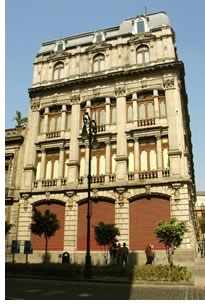 Development pressures
Development pressures
Among the sites facing development pressures is the Mexico City Historic
Center, Mexico City, founded in 1524 atop the ancient Aztec capital
of Tenochtitlan. Within the 680 square blocks that comprise the historic
center are more than 1,000 extraordinary buildings. Since the 1950s,
these issues have been compounded by air pollution, population stress,
failed economic policies, a soaring crime rate, and the continued depletion
of the city’s freshwater aquifer to hydrate a population that
recently topped 24 million. The aquifer depletion has caused the city
to drop nearly 30 feet in the past century alone. In September 1985,
a devastating earthquake measuring 8.1 on the Richter scale struck
a major blow to the metropolis, leaving in its wake 10,000 dead and
an estimated $5 billion in damage. Some have credited the earthquake
with prompting a renewal of the city that continues to this day, as
one by one the city’s most important buildings are being reclaimed
and restored. For all this progress, however, the historic center remains
at risk, not only from seismic instability, but due to the continued
sinking caused by the depletion of the aquifer, which continues unabated.
Urban planners and environmentalists have concluded that the only way
to save Mexico City is to solve the water-supply problem.
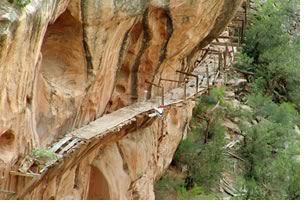 Remoteness
Remoteness
Hanging Flume, Montrose County, Colo., ranks among the more remarkable
remnants of America’s 19th-century Gold Rush. The Hanging Flume,
a 13-mile-long pathway built along the walls of Colorado’s Dolores
River Canyon, transported 8 million gallons of water a day for use
in hydraulic gold mining. Begun in 1887 for the Montrose Placer Mining
Company, the construction of the Hanging Flume demanded innovative
solutions for traversing a variety of terrain, including trestles over
ditches suspended sections attached to sheer rock faces with the aid
of cantilevered iron placements. The Flume—an extraordinary example
of 19th-century industrial engineering—was abandoned shortly
after the Montrose Placer Mining Company went bankrupt in the 1890s.
Over the years, its wood elements have been scavenged for use in other
projects, creating large gaps in the length of the structure. Surviving
stretches have been damaged by biological growth and erosion of the
sandstone cliff face. The Colorado Bureau of Land Management has requested
Watch listing with the hope of conserving the structure and presenting
it to cultural and eco-tourists.
In addition to the Cyclorama, 2 Columbus Circle, and the Hanging Flume, sites in the U.S. named to the list include:
- Bluegrass Cultural Landscape of Kentucky, Central Kentucky
- Dutch Reformed Church, Newburgh, N.Y.
- Ellis Island Baggage and Dormitory Building, New York City
- Ennis Brown House, Los Angeles
- Mount Lebanon Shaker Village, New Lebanon, N.Y.
Copyright 2005 The American Institute of Architects.
All rights reserved. Home Page ![]()
![]()
